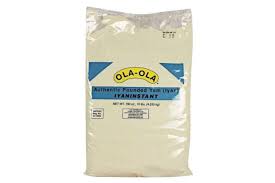
Have you ever tasted a meal so satisfying that it brings both comfort and culture in every bite? That’s exactly what pounded yam offers. It’s a staple in many West African homes, especially in Nigeria, and holds a special place in the hearts—and stomachs—of those who grew up eating it. But with the fast-paced modern lifestyle, not everyone has time to go through the traditional pounding process. That’s where pounded yam flour comes in—convenient, quick, and still delicious.
In this article, we’re diving deep into what pounded yam flour is, how it’s made, how to prepare it, and why it’s become a kitchen essential for African cuisine lovers around the globe.
What is Pounded Yam Flour?
Pounded yam flour is a processed alternative to the traditional pounded yam dish. Traditionally, pounded yam is made by boiling yam pieces and pounding them with a mortar and pestle until smooth and stretchy—almost like dough. The process is labor-intensive and time-consuming.
With pounded yam flour, all that hassle is gone. The flour is pre-cooked, dried, and ground yam that can be quickly reconstituted with hot water to create the same smooth, stretchy texture of the original.
How is Pounded Yam Flour Made?
Let’s break it down. Making pounded yam flour typically involves:
- Selection of Yams – Mature, white yams (Dioscorea rotundata) are chosen for their texture and flavor.
- Peeling and Slicing – The yams are peeled and sliced into small, uniform pieces.
- Boiling – These pieces are boiled until they become soft.
- Drying – The boiled yam is then dried using heat or sun-drying methods to remove moisture completely.
- Grinding – The dried pieces are ground into a smooth, fine powder.
- Packaging – The flour is then packaged in airtight containers to preserve freshness.
Some premium brands go a step further to pre-cook the flour, so when you’re ready to prepare it, all you need is hot water and a little elbow grease.
How to Prepare Pounded Yam from the Flour
Making pounded yam from the flour is surprisingly easy. Here’s how:
You’ll Need:
- 2 cups of pounded yam flour
- 3 cups of hot water
- A wooden spoon or spatula
Steps:
- Boil Water – Bring the water to a rolling boil.
- Stir in Flour – Slowly pour the flour into the boiling water while stirring constantly to prevent lumps.
- Mix Well – Keep stirring until it thickens and reaches a stretchy, smooth consistency.
- Adjust Texture – Add more water or flour as needed to get your preferred thickness.
- Serve Warm – Roll into balls and serve hot with your favorite soup like Egusi, Ogbono, or Okra soup.
That’s it—no pounding, no sweating, just good food in minutes!
Health Benefits of Pounded Yam Flour
You might be wondering, “Is it healthy?” The answer is yes—when consumed in moderation.
Key Health Benefits:
- Rich in Carbohydrates – Great energy source, especially for active individuals.
- Gluten-Free – Perfect for people with gluten sensitivities.
- High in Fiber – Aids digestion and helps keep you full longer.
- Contains Essential Nutrients – Including Vitamin C, potassium, and manganese.
Some brands also enrich their flour with additional nutrients or use organic farming practices for added health benefits.
Why People Love It
There’s a reason why pounded yam flour is flying off store shelves:
- Convenience – Ready in minutes compared to traditional pounding.
- Long Shelf Life – Stores well in a cool, dry place for months.
- Versatility – Works with a wide variety of African soups.
- Taste – Still offers the rich, traditional flavor of yam.
For people living abroad or those without access to fresh yams, this flour becomes a lifeline to home-cooked tradition.Pounded Yam Flour: A Taste of Tradition Made Easy
Tips for Buying the Best Pounded Yam Flour
Not all pounded yam flours are created equal. Here’s how to choose the right one:
- Check the Ingredients – It should be 100% yam with no additives or preservatives.
- Look at the Texture – The powder should be fine and uniform.
- Read Reviews – See what others are saying, especially if you’re buying online.
- Go for Trusted Brands – Brands like Poundo Yam, Ola-Ola, or Tropiway are known for quality.
Storage Tips
To keep your flour fresh and usable:
- Store in an airtight container after opening.
- Keep it in a cool, dry place—moisture is your enemy.
- If you live in a humid climate, consider refrigerating or freezing it.
Final Thoughts
Pounded yam flour is more than just a convenience—it’s a bridge between modern life and cultural heritage. Whether you grew up eating pounded yam or you’re just discovering African cuisine, this flour makes it easier than ever to enjoy the flavors of tradition without all the hard work.
Next time you crave a comforting, satisfying dish, just grab that pack of pounded yam flour, stir up some magic, and say, “Alhamdulillah”—because good food is truly a blessing.




